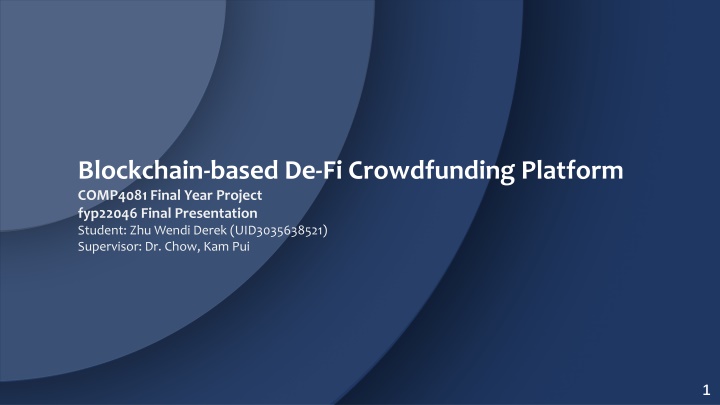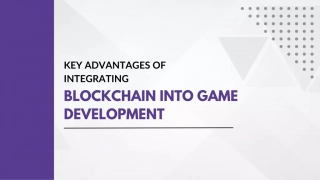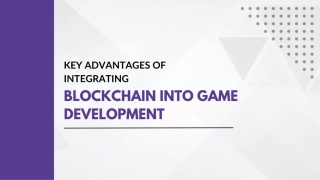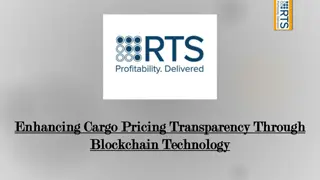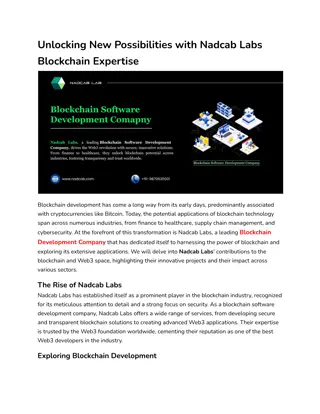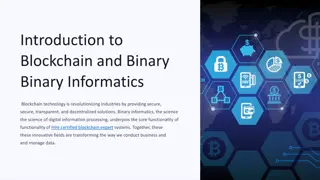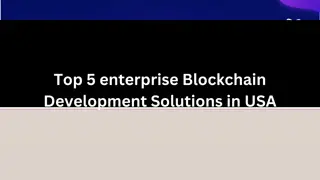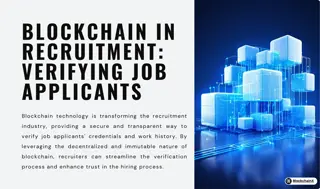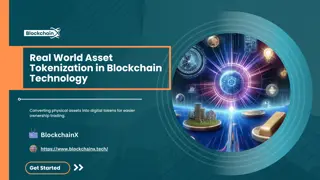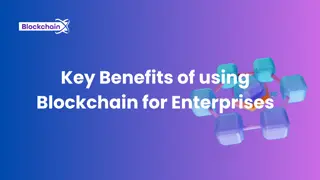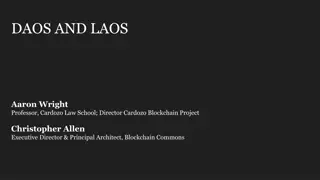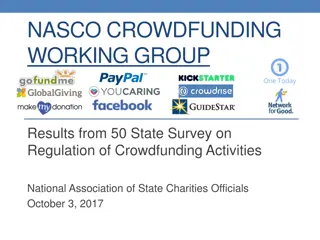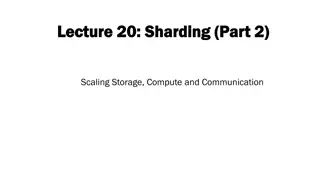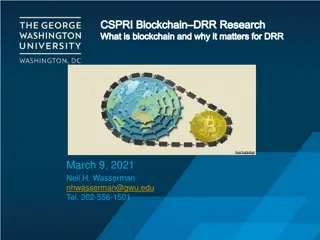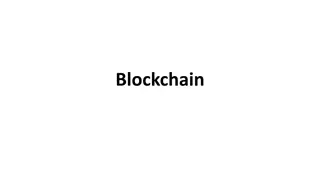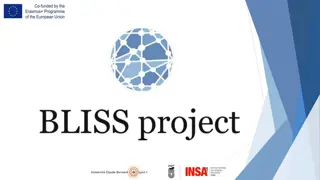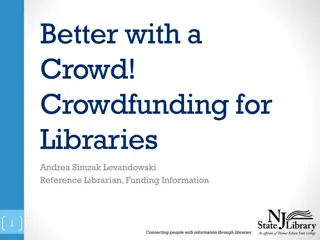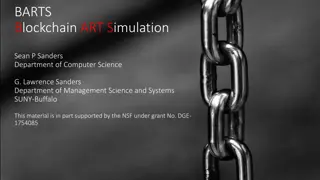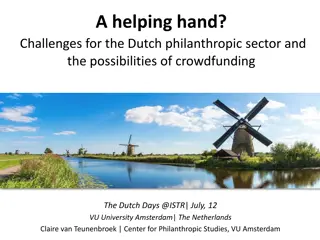Blockchain-Based De-Fi Crowdfunding Platform Final Year Project Presentation
This project explores the integration of blockchain technology and decentralized finance (De-Fi) in a crowdfunding platform to address the limitations of traditional crowdfunding systems. It discusses the background of crowdfunding, De-Fi, motivations behind the project, methodologies like blockchain implementation, application design, and concludes with the advantages of a De-Fi crowdfunding platform. The project aims to provide transparency, decentralization, and security through smart contracts for improved user engagement and trust.
Download Presentation

Please find below an Image/Link to download the presentation.
The content on the website is provided AS IS for your information and personal use only. It may not be sold, licensed, or shared on other websites without obtaining consent from the author.If you encounter any issues during the download, it is possible that the publisher has removed the file from their server.
You are allowed to download the files provided on this website for personal or commercial use, subject to the condition that they are used lawfully. All files are the property of their respective owners.
The content on the website is provided AS IS for your information and personal use only. It may not be sold, licensed, or shared on other websites without obtaining consent from the author.
E N D
Presentation Transcript
Blockchain-based De-Fi Crowdfunding Platform COMP4081 Final Year Project fyp22046 Final Presentation Student: Zhu Wendi Derek (UID3035638521) Supervisor: Dr. Chow, Kam Pui 1
Outline 1. Background Introduction 1.1 Crowdfunding 1.2 De-Fi 1.3 Motivations 2. Methodologies 2.1 Blockchain 2.2 Decentralized Application 2.2.1 Smart Contract 2.2.2 Web Application 3. Application Design 3.1 Application Architecture 3.2 Campaign Design 3.3 Frontend UI 4. Conclusions References Q&A 2
1. Background Introduction 1.1 Crowdfunding Crowdfunding Platform (CFP) CFPs Backer Fundraiser Advantages: Flexibility Convenience User participation Limitations: Security: Users must trust the CFPs Non-transparency: Where the funds are being used Managing fee Low efficiency Global contribution: CFPs and fundraisers have to deal with various legal environments 3
1. Background Introduction 1.2 De-Fi Decentralized Finance Provide financial infrastructure based on the blockchain and smart contracts. Purpose: token issuance, automated coin exchange, decentralized lending platforms, decentralized derivatives, On-Chain Asset Management, etc. Token Dai Market Cap 6.2 billion Blockchain ETH (ERC-20) Type Stable Coin (US Dollar) Uniswap 5.1 billion ETH (ERC-20) Automated Exchange Avalanche 5.0 billion Avalanche Blockchain platform Wrapped Bitcoin 4.9 billion ETH(ERC-20) Stable Coin (Bitcoin) Chainlink 3.5 billion ETH(ERC-20) Oracle networks Luna 1.6 billion Terra Decentralized Stable Coin Table 1 Top 6 DeFi Projects sorted by the marked cap (Nov, 2022) 4
1. Background Introduction 1.3 Motivations Limitations of Traditional CFPs Non-transparency Agency fee Low efficiency Trust issue Various legal environment Advantages of De-Fi Transparency Decentralization Secured by smart-contracts Monitorable transactions User engagement Solution: A De-Fi Crowdfunding Platform 5
2. Methodologies 2.1 Blockchain Public blockchain, support Ethereum Virtual Machine Efficient and secure. Alternative Analysis Ethereum (not chosen) Scalability: transaction speed, gas fee Sovereignty: shared underlying environment Ethereum Layer 2 scaling the Ethereum (not chosen) Stability and security Reduced security and decentralization Poor interoperability between different Layer2 The application is highly relay on the Layer-2 platforms 6
2. Methodologies 2.1 Blockchain Cosmos Ecosystem Name BNB Blockchain Binance Chain Cosmos is a decentralized network of independent parallel blockchains. It is highly suited to building application-specific blockchains, or app-chains. Luna Terra Developers can customize blockchains from scratch that can natively interoperate with other blockchains. CRO Crypto.com OKT OKExChain Cosmos SDK. One of the most popular framework for building application-specific blockchains. Table 2 Some of the famous projects on Cosmos Inter-Blockchain Communication Protocol (IBC) 7
2. Methodologies 2.1 Blockchain Evmos and Evmos Testnet Evmos is a blockchain network in the Cosmos Ecosystem that supports the Ethereum Virtual Machine (EVM). By adopting the IBC protocol of Cosmos, which is a trust-minimized "cross-chain" approach, applications can avoid being isolated. Evmos Testnet: Evmos Testnet is a public blockchain network that runs parallel to the Mainnet, allowing developers to test and deploy their D-Apps safely and securely without spending real funds. 8
2. Methodologies 2.2 Decentralized Application Web Browser Frontend Web Browser Frontend Web Browser Frontend Web Browser Frontend Web Browser Frontend Web Server Backend Node Node Smart Contract Smart Contract P2P network SQL Server Database Blockchain Blockchain Traditional App Architecture D-App Architecture 9
2. Methodologies 2.2 Decentralized Application 2.2.1 Smart Contract Developed and Tested using Remix IDE Compiled and Deployed using Truffle 2.2.2 Web Application React: an open-source JavaScript library for building user interfaces Web3.js: a JavaScript library that provides a standardized way to interact with the blockchain 10
3. Application Design 3.1 Application Architecture Customize Campaign Query Campaigns List Campaign Factory Block A Deployed By Admin Terminal (Truffle) Block B Generate Block C Campaign 0 Deployed By Factory Web Page (Ract, Web3.js) Block D Campaign 1 Deployed By Factory Send Transactions Query Campaigns Details 11
3. Application Design 3.2 Campaign Design Backer Raiser Create Contribute Refund Raiser: Create Campaign Create Request Campaign Pool Backer: Contribute Approve Request Send token Withdraw Request_0 Create Vote for Request_0 Request_1 Request_3 12
3. Application Design 3.2 Campaign Design Lifecycle Campaign Life Cycle Request Life Cycle Campaign Lifespan: [7 days, 300 days], customized by raiser. Backers can get refund when the campaign is end. Request Lifespan: 7 days. A new Request can only be created if last Request is already end. Request Life Cycle After Day7 Determine Voting Result Raiser get withdraw > 50% Request end Request Voting Mechanism Day1 Day7 Voting Period: from day 1 to day 7. Voting Result: will be determined when voting period is end. Voting Power: determined by the backers contribution balance in the fund pools. 13
3. Application Design 3.3 Frontend Home Page View Campaign List Make Contribution Create Campaign Description Set target and lifespan 14
3. Application Design 3.3 Frontend Campaign Page View Campaign inf0 Raiser update info Raiser create request Backers apply for refund Create Request Description Set withdraw amount 15
3. Application Design 3.3 Frontend Wallet Extension and Block Explorer MetaMask Sign transactions that can change the smart contracts status Block Explorer View account transaction history 16
4. Conclusion Outcomes: A DeFi crowdfunding Platform was build A Smart contracts running on the Evmos Testnet A Decentralized Platform that can interact with the blockchain Users can influence project decisions through Voting Power Decentralized crowdfunding becomes possible Users can easily deploy this open-source project on any blockchain that supports EVM Limitations: The Instability of Blockchain Token Value Anonymous attacks Future Works How to advantages of IBC 17
References [1] P. Belleflamme, N. Omrani and M. Peitz, "The Economics of Crowdfunding Platforms", Information Economics and Policy, 2015. [2] N. Salido-Andres, M. Rey-Garcia, L. I. lvarez-Gonz lez, and R. V zquez-Casielles, Determinants of success of donation-based crowdfunding through digital platforms: The influence of offline factors, CIRIEC-Espa a, revista de econom a p blica, social y cooperativa, no. 95, 2019. [3] F. Sch r, "Decentralized Finance: On Blockchain- and Smart Contract-Based Financial Markets," Federal Reserve Bank of St. Louis Review, Second Quarter 2021, pp. 153-74. [4] "Top DeFi Coins by Market Capitalization," crypto.com, [Online]. Available: https://crypto.com/price/categories/defi. [Accessed: 26-Oct-2022]. [5]"Cosmos SDK Documentation," Docs.cosmos.network, 2022. [Online]. Available: https://docs.cosmos.network/. [Accessed: 01- Oct- 2022]. [6] "Evmos Develop Documentation," Evmos.Docs, 2023. [Online]. Available: https://docs.evmos.org/develop/. [Accessed: 01- March- 2023]. [7] "web3.js Ethereum JavaScript API," Web3, 2023. [Online]. Available: https://web3js.readthedocs.io/en/v1.8.2/. [Accessed: 01- March- 2023]. 18
Thanks For Your Listening Q&A 19
